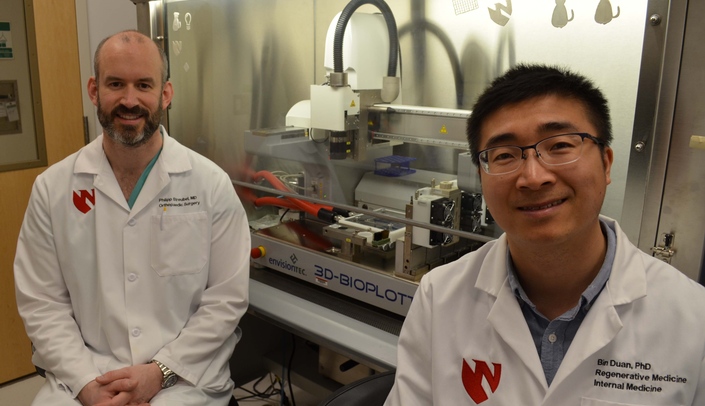The National Institutes of Health has awarded the University of Nebraska Medical Center a five-year, $1.9 million grant to study severe tears of the rotator cuff, a common problem that impacts thousands of people every year.
The rotator cuff is a set of four muscles and tendons that play a key role in function of the shoulder. When injuries of the rotator cuff aren’t treated adequately, they may significantly affect quality of life. The result can be ongoing shoulder pain, inability to raise the arm, and, eventually shoulder arthritis.
“Rotator cuff pathology is one of the main clinical problems we treat in shoulder surgery,” said Philipp Streubel, M.D., associate professor of orthopedic surgery and an orthopedic surgeon who specializes in shoulder surgery at Nebraska Medicine. “We’re trying to find a better way to fix them, especially in younger people with large tears where we don’t have enough tissue to repair them.
“Small tears can be fixed and they heal uneventfully in the vast majority of cases. However, when you have a large irreparable tear, healing responses can drop down to single digit percentages.”
Dr. Streubel and UNMC biomedical engineer, Bin Duan, Ph.D., assistant professor in the division of cardiovascular medicine and the Mary & Dick Holland Regenerative Medicine Program, are the principal investigators of the NIH grant.
Dr. Duan said the team’s goal is to engineer a rotator cuff graft, using a special 3D printer and bio ink to mimic the native structure of the rotator cuff. In his lab, he is creating tissue specific cell structures on woven nanofiber textiles with the help of a 3D printer. The structure will then be tested in rotator cuff tears in laboratory animal models.
Currently, there are multiple tissue options available to graft large irreparable tears, but the results are mixed. In their study, Drs. Duan and Streubel will use cutting-edge technology to create scaffolds they hope will ultimately repopulate with the patient’s own cells, while closely mimicking the complex microstructure of muscle, tendon and bone.
“Despite the current advances in tissue augmentation, the reported overall failure rate is between 15 and 40 percent,” Dr. Streubel said. “One of the current problems is we’re trying to fill up a complex type of tissue with a more simple structural graft.
“Irreparable rotator cuff tears are missing tissue that transitions through multiple types of properties from muscle into tendon and finally into bone. Current graft options only provide a single type of tissue which has proven to be suboptimal,” he said.
More than 250,000 rotator cuff repair surgeries are performed annually in the U.S. alone.
Preliminary studies have shown the bioengineered grafts to be safe and viable. They are now testing if the graft is effective in repairing rotator cuff tears.
“I think it’s important to have the connection between the researcher and clinician to target a clinical problem,” Dr. Duan said. “We can only find these innovative solutions by collaborating across specialties and scientific fields.”
The research builds on the work Dr. Duan has done over the last several years.
Dr. Streubel said the availability of nano yarns (yarns of calibers within the nanometer range) has allowed Dr. Duan to create very unique woven textiles that provide the backbone onto which tissue specific cells and growth factors can be printed on. Hydrogels containing these cells and growth factors are used as biologic inks that are then printed into three-dimensional structures.”
We are Nebraska Medicine and UNMC. Our mission is to lead the world in transforming lives to create a healthy future for all individuals and communities through premier educational programs, innovative research and extraordinary patient care.
Twitter | Facebook | Instagram | YouTube | Flickr
UNMC lands $1.9 million to evaluate new way to repair rotator cuff injuries
- Written by Vicky Cerino
- Published Mar 28, 2019

Media Contact
Vicky Cerino
UNMC Strategic Communications
(402) 559-5190
(402) 559-4353
vcerino@unmc.edu